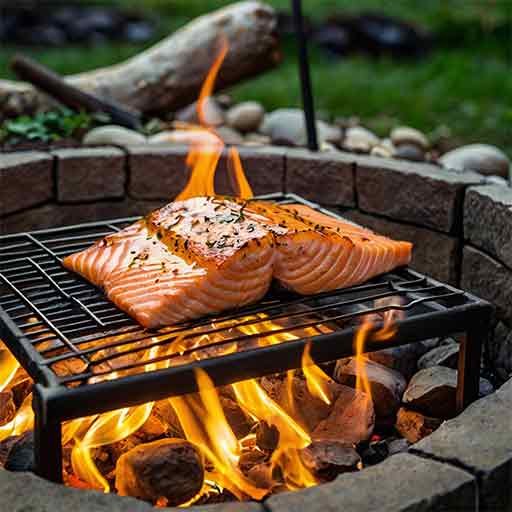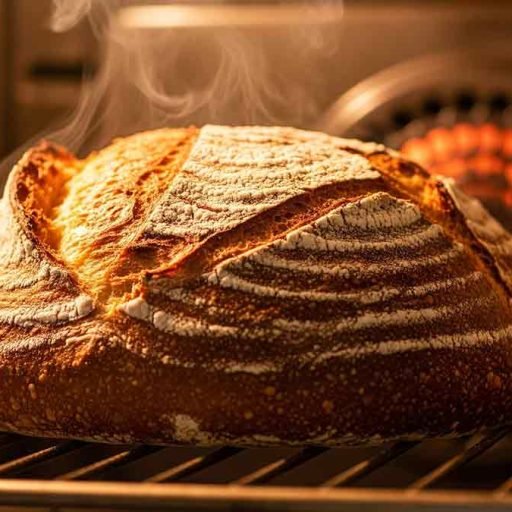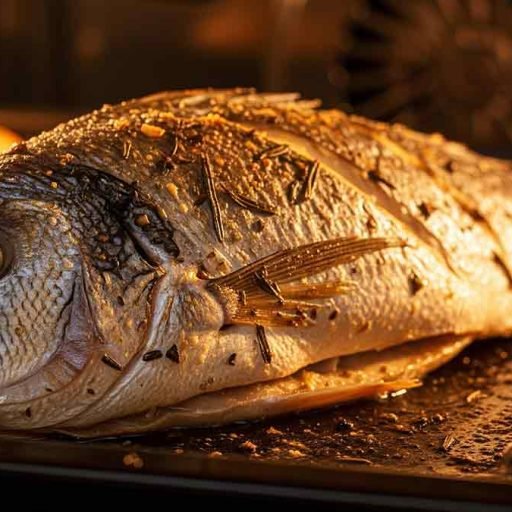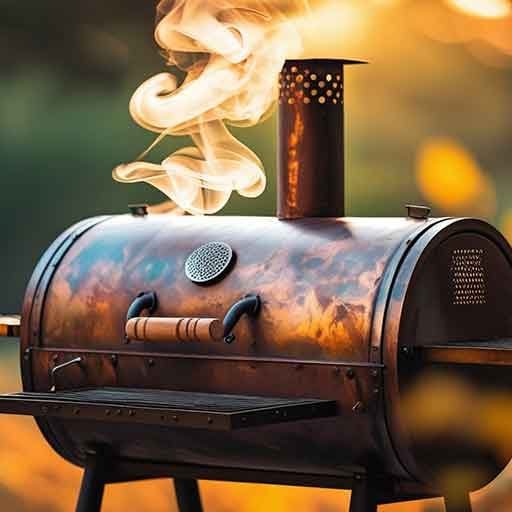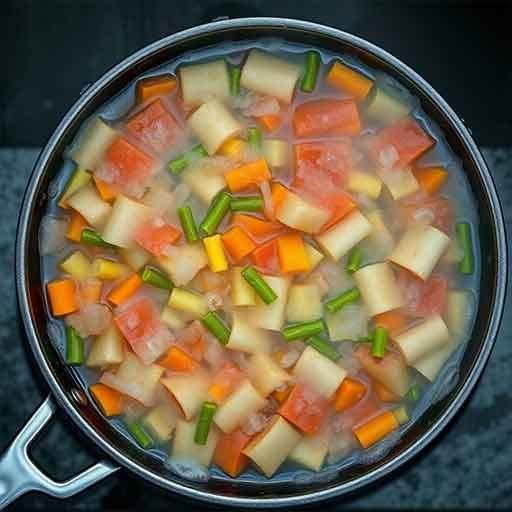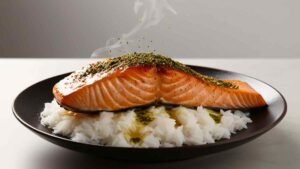What is a fire pit cooking? Fire pit cooking is a dry heat cooking method In the most basic sense, a fire pit is just that “A Pit of Fire“. What started as a simple hole in the ground, in which burning wood supplied heat for warmth and cooking, has become more practical and safe over the centuries through design. Many of us think of a firepit as simply a vessel that burns wood, over which a suspended grill or hotplate can be fitted to cook food.
The most basic fire pit I’ve seen is a recycled metal drum with holes drilled in it to provide airflow and enable the wood to burn (remember: fire needs oxygen ). A grill, like an old oven grill, is placed over a metal drum. After the smoke and flames have subsided, the fire is ready to cook on the heat emitted from the hot charcoal.
It is the heat from the charcoal that is required for cooking. You’ll notice that when the wood is burning, it’s almost as if it’s alive: it hisses, spits, and groans. These sounds are produced by burning minerals and water in the wood; its harmful effect is smoke. Smoke and soot are released while the volatiles in the wood are still burning. And smoke is something you don’t want when you’re cooking over an open fire pit.
Cooking over a smoky fire gives food an unpleasant diesel-like taste. When the noise and smoke subsides, you’re left with charcoal, which burns hotter than wood and glows and pulses with heat. It will have few visible flames, releasing only pure heat. Achieving this takes time, and requires patience.
Firewood for Fire Pit Cooking
You might think wood is wood – but there are many different types of trees. The soft wood of trees such as cypress, pine, and cedar burns very quickly and is not good for a fire. These woods may be less expensive, but they won’t go the distance. Do not burn treated wood from trees and other large plants that are poisonous. Many of us know that oleander, for example, is poisonous, and should not be burned anywhere near people. The same goes for any treated or painted wood.
In Australia and New Zealand, the best firewood is hardwood gum or eucalyptus. Timber in Australia varies slightly from state to state. In general, the woods that burn the longest are jarrah, ironbark, boxwood, and red river gum.
The same applies when choosing firewood in North America, the UK, and Europe. Wood with minimal pitch (resin) or sap is the best choice for burning on a fire pit. In North America, it is maple, ash, birch, and oak wood. The most commonly available firewood in the UK and Europe is similar to that in North America but also includes hardwood fruit trees, such as cherries and apples.
The best wood for burning will feel dense, be gray (certainly not green), sound hollow when two logs are tapped together, and be free of fibrous bark, or at least that. indicates that the bark can be easily broken. What you are looking for is wood that is as dry as possible. Greenwood, or wood with some bark attached, indicates that the wood has moisture, which will produce more smoke and require more energy to burn off the water and minerals. Worse, it may not burn at all. Always go for grey, dry, and dense.
How to Prepare the firepit for cooking
Many modern fire pits will come with an attached grill, perfect for cooking. Remove the grill when you light the coals. Take two medium-sized pieces of wood and place them in the center of the fire pit, parallel to each other and about 20 cm (8 inches) apart. Take two more pieces of wood of the same size and place them on top, on opposite sides, parallel, and 20 cm (8 inches) apart. There will be a gap in the center where you start the fire.
Crumple some newspapers into loose balls and place them between the wood (egg cartons also work as a treat). Now arrange some kindling around the paper to look like a teepee. Light the newspaper in several places, allowing it to catch and burn – kindling won’t take long to catch fire, but larger pieces of wood will take a little longer. You can use a piece of cardboard or a baking tray to fan the fire and encourage it to burn.
When is the fire pit ready?
Over about 2 hours, the wood darkens and eventually turns into charcoal. It will break into small pieces that are supercharged with energy and glow with intense heat. Coals about the size of a golf ball, and no bigger than a tennis ball, are the ones you want to cook with. And, unlike wood, which requires space to burn, these hot coals work best when pushed together to generate and retain maximum heat for cooking.
The easiest way to test if your Fire Pit is ready to cook is to trust your senses. First, use your eyes: you want to see small pieces of red-hot coals with minimal smoke. Second, use your sense of touch. Place the palm of your hand about 5–10 cm (2–4 in) in the center of the fire pit. You should only be able to hold your hand there for 2-3 seconds. Replace the grill over the fire pit and allow it to heat up for about 10 minutes.
Wood needs air and space to burn, so don’t overcrowd it. Give it time and space to turn into coals. It’s not wood you need to cook with. This is what makes wood.
What tools do you need?
You can treat a fire pit like any other open fireplace inside the house. That is, you can have a fireplace kit that includes a hand shovel, ember movers, and bellows. All of these would be useful – but not essential. I got something long and made of metal to put out the fire, plus a pair of long metal cooking tongs.
It’s always a good idea to have a dustpan and brush handy for cleaning when the fire pit has cooled completely. If your fire pit is small enough, you can put the burnt coals and ashes directly into your compost bin or compost pile. My local council provides large bins for organic matter and they accept ashes.
What to cook on a fire pit
Meat
You can cook almost everything that you can cook on a conventional barbecue. But, do remember that the firepit does not have a lid that can close and trap heat, acting like an oven of sorts. Keep in mind that smaller cuts of meat cook best on a firepit. Chicken fillet is ideal; darker thigh meat, with lines of fat, is ideal. You can, of course, use chicken breast fillet, but I find this too dry and not as flavorsome as the thigh. Cute little trimmed lamb cutlets are perfect. The bone is all ready to use as a utensil to hold the chop and wolf down the tender meat. beef cutlets are good, too, as are most fillets of red meat: lamb, beef.
vegetables
While larger bits of meat can be cooked on the firepit, they do require more attention and patience. To ensure large dense cuts of meat are cooked through, a good tip is to wrap the seared meat in foil and move to the edge of the firepit. Here the heat is less intense and the meat can cook through without burning.
Many vegetables are perfect for cooking on the firepit. Whole or thickly sliced eggplant (aubergine) and capsicum (pepper) are ideal; so too are root vegetables like sweet potato and potato, wrapped in foil and ready to be smothered in butter, sour cream, yogurt or labneh. Sweetcorn, too, cooks to perfection on the firepit. Patiently turn the corn over the heat until the kernels burst with a golden flavor that’s hard to beat.
Seafood
With seafood, large prawns and lobsters fair well, especially when left in their shell, which acts as natural protective armor. Delicate white fish fillets are best wrapped in a foil parcel and need very little cooking time. For drama, the firepit is the way to go for cooking your favorite whole fish. Again, whole fish is best wrapped in some sort of parcel made of baking paper with an outside layer of foil. (The paper-thin skin of many fish will stick to the cooking foil and it can prove very tricky to peel off once the fish is cooked; hence the baking paper on the inside.) These sturdy parcels also make it easier to transfer the fish from the firepit to a serving platter.
Can I Cook on an Open Fire Pit?
Yes, you can cook on an open fire pit, but it requires some preparation and caution. Here are a few tips:
- Choose the Right Wood: Use hardwoods for better flavor and heat.
- Manage the Fire: Control the flame size and heat distribution to create different cooking zones.
- Use Cooking Accessories: A grill grate or other cooking accessories are necessary for cooking over an open fire pit.
- Ensure Safety: Keep the fire in a safe location and never leave it unattended.
How to Cook Corn on the Cob in a Fire Pit
Cooking corn on the cob in a fire pit is a simple and delicious process:
- Prepare the Corn: Remove the silk from the corn and soak the ears in cold water for about 30 minutes.
- Grill Over Medium Heat: Place the corn over medium heat, turning every 5 minutes until the corn is tender and lightly charred.
- Use Campfire Coals: For a campfire setup, use hot coals rather than open flames to roast the corn evenly.
- Season: Once cooked, pull back the husks and season with butter, salt, and pepper if desired.
Can You Cook Food Over a Rusty Fire Pit?
It is not recommended to cook food over a rusty fire pit. Rust can contaminate food and pose health risks. Here’s how to handle a rusty fire pit:
- Remove the Rust: Use chemical-based removal products or natural methods like sandpaper or potatoes to remove the rust.
- Prevent Future Rust: Keep your fire pit under a cover, clean and dry it regularly, and apply edible vegetable oil to seal and protect the metal surface.
Can You Cook Hotdogs on a Propane Gas Fire Pit?
Yes, you can cook hotdogs on a propane gas fire pit. Here’s how:
- Set Up the Grill Grate: Lay a grill grate over the top of the fire pit to create a cooking surface.
- Control the Heat: Adjust the flame to maintain a consistent temperature.
- Cook the Hotdogs: Place the hotdogs on the grill grate and cook until they are heated through and slightly charred.
- Ensure Safety: Follow safety guidelines, such as ensuring proper ventilation to prevent carbon monoxide buildup.
Can You Cook on a Fire Pit?
Absolutely, you can cook on a fire pit, whether it is a wood-burning or propane gas model. Here are some general tips:
- Use Appropriate Cooking Accessories: A grill grate or other cooking tools are necessary.
- Manage the Fire: Control the heat and flame size for different cooking needs.
- Ensure Safety: Keep the fire in a safe location and follow all safety guidelines.
- Experiment with Recipes: From simple hotdogs and burgers to more complex meals like skewers and stews, the possibilities are endless.
